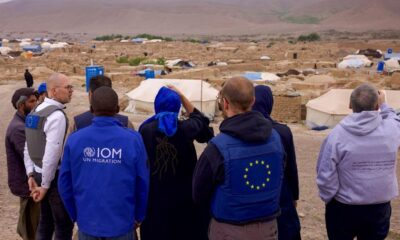Latest News
2016 Bloodiest Year for Journalists in Afghanistan

 2016 was the deadliest and bloodiest year for journalists in Afghanistan with a 38 percent increase in violence against journalists compared to the previous years.
2016 was the deadliest and bloodiest year for journalists in Afghanistan with a 38 percent increase in violence against journalists compared to the previous years.
Afghanistan Journalist Safety Committee (AJSC) said in a report released on Thursday said that With 13 killed, 2016 was the deadliest year for journalists in the history of Afghanistan's media.
According to the report, 6 journalists were wounded during the year, while the agency also documented, "30 cases of beating, 35 cases of intimidation, and 17 cases of abuse and mistreatment."
With 101 cases in total, the year saw a spike of 38 per cent in instances of violence against journalists compared to 2015, with 50 per cent attributed to the government of Afghanistan, while the Taliban accounted for 20 per cent. Most of the remaining cases were attributed to unknown individuals.
"An increase in the level of threats and attacks against journalist and media by the Taliban has not only transformed the nature of the threat environment, but also forced extensive self-censorship on journalists who work in the insecure areas of the country," the report said.
"Not only the violence became heavier in terms of qualitative but the statistics also show a 38 percent increase in violence," said Najib Sharifi, head of AJSC.
AJSC calls on government to take serious measures for reducing violence against journalists in the country.
"We urge the government leaders and the international community to take this issue serious and also take serious measures regarding this issue," Sharifi added.
The AJSC is demanding that the Afghan government ends the culture of impunity surrounding journalist deaths. It warns that otherwise the country will lose its vibrant local media, one of Afghanistan's greatest achievements since the 2001 fall of the Taliban.
Journalists’ rights bodies blame the Afghan government and militant groups for committing violence against journalists, urging the government to protect them from further threats.

Latest News
IEA and Syrian FMs hold phone talks, express hope for bilateral ties

The Islamic Emirate's Acting Foreign Minister Amir Khan Muttaqi has held a telephone conversation with Syrian Foreign Minister Asaad Hassan al-Shibani, the ministry said in a statement.
Hafiz Zia Ahmad Takal, the Ministry's deputy spokesman, stated that during the conversation, Muttaqi congratulated the Syrian government on their success, praised their stance on general amnesty and good governance, and expressed hope for the establishment of regular diplomatic relations between Afghanistan and Syria.
Takal added that the Syrian Foreign Minister also expressed hope for the expansion of bilateral ties and for delegations from both sides to meet and engage in discussions.
Latest News
IEA spokesman announces NDC has built a rail for the first time

Zabihullah Mujahid, spokesperson for the Islamic Emirate, has announced that the National Development Corporation (NDC) has successfully built a rail for the first time in Afghanistan.
Previously, Mujahid also revealed that the NDC had produced both a freight truck and a passenger vehicle, further highlighting the corporation's growing role in boosting Afghanistan's industrial capabilities.
Latest News
Qosh Tepa Canal phase 2 surpasses 81% completion

In a significant milestone for Afghanistan's infrastructure development, officials from the National Development Corporation (NDC) have announced that the second phase of the Qosh Tepa Canal in northern Afghanistan is now 81 percent complete, with the construction of its dam progressing steadily at 67 percent. This ambitious project is poised to transform the region, enhancing irrigation systems and boosting agricultural productivity.
The ongoing work on this irrigation project is taking place in the Andkhoy district of Faryab province, where hundreds of machines are actively involved. NDC officials have confirmed that the second phase of the canal will be completed in the coming months.
Nabiullah Arghandiwal, spokesperson for the NDC, stated, “The second phase of the Qosh Tepa Canal is currently 81 percent complete, with thousands of machines and workers engaged in the project.”
Arghandiwal also highlighted the construction of six large bridges along the canal in Balkh and Jawzjan provinces. Two of the bridges are completed, and the remaining four are expected to be operational soon.
Economic experts believe that once completed, the canal will help Afghanistan achieve self-sufficiency in grain production and generate numerous job opportunities in various sectors.
Young workers involved in the project have expressed their satisfaction with the employment opportunities it provides. They are calling on the government to launch similar development projects to combat youth unemployment.
Abdul Ghani, a worker, remarked, “This project is progressing very well, and I urge the Islamic Emirate to implement similar projects.”
It is important to note that the entire funding for the Qosh Tepa Canal project is sourced from domestic revenue.
-

 Latest News4 days ago
Latest News4 days agoOver 50 Afghan inmates freed from Pakistani prisons
-

 Latest News5 days ago
Latest News5 days agoSaudi Arabia reopens embassy in Afghanistan
-

 Latest News5 days ago
Latest News5 days agoTrump criticizes abandoning of equipment in Afghanistan, vows to rebuild military
-

 World4 days ago
World4 days agoIsraeli defense minister claims responsibility for first time for Hamas leader Haniyeh’s assassination
-

 Latest News4 days ago
Latest News4 days agoJapan, UNDP launch new community resilience programme in Afghanistan
-

 Latest News5 days ago
Latest News5 days agoIOM appeals for nearly $500 million to support Afghans in 2025
-

 Latest News4 days ago
Latest News4 days agoMines ministry signs cement production contract in Logar with private company
-

 Sport4 days ago
Sport4 days agoICC announces schedule for 2025 Men’s Champions Trophy
















